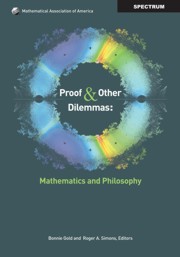Book contents
- Frontmatter
- Contents
- Acknowledgments
- Introduction
- I Proof and How it is Changing
- 1 Proof: Its Nature and Significance
- 2 Implications of Experimental Mathematics for the Philosophy of Mathematics
- 3 On the Roles of Proof in Mathematics
- II Social Constructivist Views of Mathematics
- III The Nature of Mathematical Objects and Mathematical Knowledge
- IV The Nature of Mathematics and its Applications
- Glossary of Common Philosophical Terms
- About the Editors
1 - Proof: Its Nature and Significance
from I - Proof and How it is Changing
- Frontmatter
- Contents
- Acknowledgments
- Introduction
- I Proof and How it is Changing
- 1 Proof: Its Nature and Significance
- 2 Implications of Experimental Mathematics for the Philosophy of Mathematics
- 3 On the Roles of Proof in Mathematics
- II Social Constructivist Views of Mathematics
- III The Nature of Mathematical Objects and Mathematical Knowledge
- IV The Nature of Mathematics and its Applications
- Glossary of Common Philosophical Terms
- About the Editors
Summary
From the Editors
In our first chapter, Michael Detlefsen carefully examines the historical tension between inductive and deductive methods in mathematics, and relates it to the current discussion of the roles of each in the development of mathematics. He then turns to the question of whether, in fact, formalization of proofs actually increases either understanding or reliability of proofs. He also summarizes recent work on diagrammatic reasoning in mathematics, and the possible roles of visual experience in proofs.
We have chosen this as the first chapter in the book because we believe it is a fine, careful examination of these questions that virtually every reader of this volume will benefit from reading. For those of us who teach mathematics, an awareness of the fluctuations in the role of proof, and what is considered a proof, can be of use in the classroom. Such awareness can give us both a context in which to set our students' attempts at proof and a historical background we can impart to our students. An awareness of the importance of inductive methods in the development of mathematics is also worth transmitting to our students. In particular, making students aware of the current discussion in the mathematical community about the role of computers in mathematics can help them realize that mathematics is still a growing subject, even if most of the mathematics they study at the undergraduate level is centuries old.
- Type
- Chapter
- Information
- Proof and Other DilemmasMathematics and Philosophy, pp. 3 - 32Publisher: Mathematical Association of AmericaPrint publication year: 2008
- 1
- Cited by



